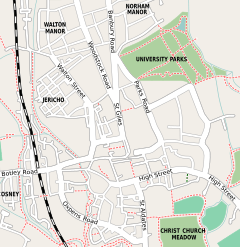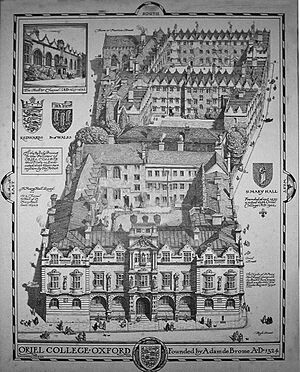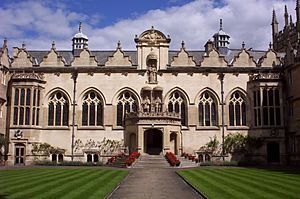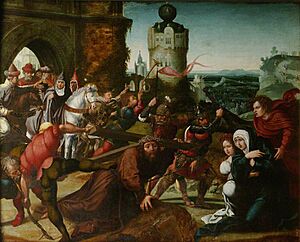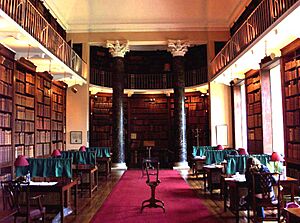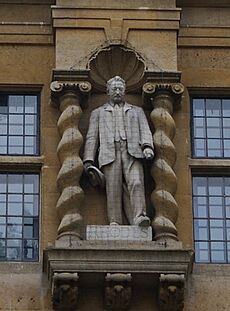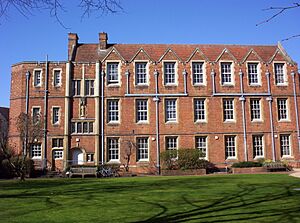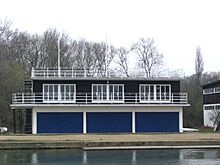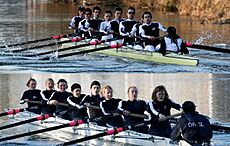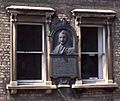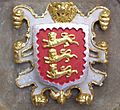Oriel College, Oxford facts for kids
Quick facts for kids Oriel College |
|||||||||||||
|---|---|---|---|---|---|---|---|---|---|---|---|---|---|
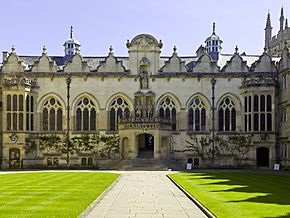 |
|||||||||||||
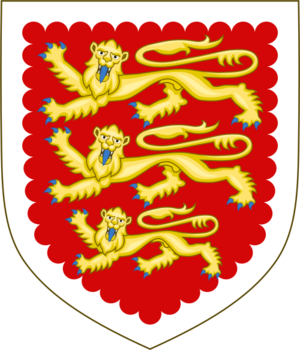
Blazon: Gules, three lions passant guardant in pale or, a bordure engrailed argent
|
|||||||||||||
|
|
|||||||||||||
| University | University of Oxford | ||||||||||||
| Location | Oriel Square, Oxford OX1 4EW | ||||||||||||
| Coordinates | 51°45′07″N 1°15′14″W / 51.7519°N 1.2538°W | ||||||||||||
| Full name | The Provost and Scholars of the House of the Blessed Mary the Virgin in Oxford, commonly called Oriel College, of the Foundation of Edward the Second of famous memory, sometime King of England | ||||||||||||
| Latin name | Collegium Orielense Prepositus et Scholares domus beate Marie Virginis in Oxonia vulgariter vocata Oriell Colledge de fundatione inclite memorie Edwardi quondam Regis Anglie secundi |
||||||||||||
| Founders | |||||||||||||
| Established | 1324 | ||||||||||||
| Founded | 1326 | ||||||||||||
| Named for | Blessed Virgin Mary; oriel window | ||||||||||||
| Sister colleges | |||||||||||||
| Provost | The Lord Mendoza | ||||||||||||
| Undergraduates | 335 (2021–22) | ||||||||||||
| Postgraduates | 220 (2021–22) | ||||||||||||
| Boat club | Oriel College Boat Club | ||||||||||||
| Map | |||||||||||||
Oriel College is a part of the famous University of Oxford in Oxford, England. It's located in Oriel Square. This college is special because it's the oldest college in Oxford to be founded by a king. Because of this royal link, it was also known as King's College or King's Hall a long time ago. The current King of the United Kingdom, Charles III, is the official visitor of the college.
Oriel College was first started in 1324 by Adam de Brome, with help from King Edward II of England. It was first called the House of the Blessed Mary at Oxford. The college received its official royal permission in 1326. In 1329, the college got a large house called La Oriole from the King. This house is where the college got its common name, "Oriel."
At first, the college was for a leader (called a provost) and ten scholars. It stayed a small group of graduate scholars until the 1500s when it started to accept younger students. During the English Civil War, important members of the King's Parliament stayed at Oriel.
The main part of the college includes four old medieval buildings. One of these, Tackley's Inn, is the oldest standing medieval building in Oxford. Today, Oriel College has almost 40 teachers (fellows), about 300 undergraduate students, and around 250 graduate students. Oriel was the last men-only college at Oxford to allow women to study there in 1985. Now, there are almost equal numbers of men and women students. Many famous people have studied at Oriel, including two Nobel Prize winners.
Contents
History of Oriel College
How Oriel College Began
On April 24, 1324, Adam de Brome, who was in charge of the University Church of St Mary the Virgin, got permission from King Edward II to start a college. This college was for scholars to study different subjects in honor of the Virgin Mary. Brome bought two properties in 1324 to help fund the college.

The King officially approved Brome's college on January 21, 1326. The King's representative, the Lord Chancellor, was meant to oversee the college. However, another document in May of that year gave this role to Henry Burghersh, the Bishop of Lincoln. This was because Oxford was part of the diocese of Lincoln at that time. With King Edward's support, Brome used money from the University Church to help his new college.
After King Edward II was removed from power, the college quickly sought favor from the new king, Edward III. In February 1327, Edward III confirmed his father's support. In 1329, the college received a large royal house called La Oriole. This house is on the site of what is now the First Quad. The college got its common name, "Oriel," from this property. The name "Oriel" was used from about 1349. It referred to an oratoriolum, which was a special window or small room for prayer.
In the early 1400s, some Oriel fellows were involved in disagreements about religious ideas. They had strong opinions about how religious power should work.
In 1442, King Henry VI made a deal. The town would pay the college £25 a year. In return, the college gave up some old property that was too expensive to fix. This arrangement was later canceled in 1450.
Oriel in Early Modern Times
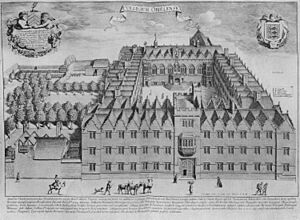
In 1643, during the First English Civil War, Oxford colleges had to support the King's side. Oriel College gave almost all its valuable silver to the King. The college also had to pay a weekly sum to help fortify the city. When the Oxford Parliament met in 1644, Oriel housed important members of the King's government.
After the King's side lost the war, the university was checked by the Parliamentarians. Five of Oriel's eighteen teachers were removed. The college then regained its ability to choose its own teachers.
In 1673, a teacher named James Davenant complained about the Provost's (college head's) actions in choosing a new teacher. The Bishop of Lincoln set up a group to investigate. The Bishop then made rules to ensure that elections were fair.
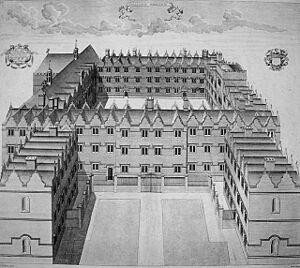
In the early 1720s, a disagreement started between the provost and the teachers. This led to a lawsuit. The teachers argued that the King was the college's true overseer, making the Bishop's decisions invalid. The provost and Bishop argued that the Bishop of Lincoln was the overseer. A jury decided in favor of the teachers, supporting the original document from King Edward II.
In the 1700s, Oriel College celebrated many special feasts called "Gaudies." By the late 1800s, only two of these feasts were still celebrated.
Oriel in Modern Times
In the early 1800s, Oriel became known as a very smart college. It was the center of a group called the "Oriel Noetics," who were liberal thinkers. In the 1830s, two important Oriel teachers, John Keble and Saint John Henry Newman, started a group known as the Oxford Movement. They wanted to bring back the spirit of early Christianity to the Church of England. There was some tension in the college because the Provost, Edward Hawkins, was against this movement.
During World War I, a wall was built to separate parts of Oriel College. This was to make space for students from Somerville College, whose buildings were used as a military hospital. At that time, male and female students were kept separate. A student named Vera Brittain wrote about a funny event when a hole appeared in the dividing wall.
In 1985, Oriel College became the last all-male college in Oxford to start accepting women students. In 1984, the college's senior teachers voted to admit women from 1986. Some students at the time worried that the college's unique character would change.
In 2007, a new feast day was added to be celebrated around Saint George's Day (April 23). This dinner is a formal event where guests wear black tie and gowns.
Buildings and Areas
First Quad (Front Quad)
The land for Oriel College was bought between 1329 and 1392. None of the first buildings remain. They were taken down before the main square area (quadrangle) was built in the 1600s. The south and west sides, and the main gate tower, were built around 1620-1622. The north and east sides, and the chapel, were built from 1637-1642. The east side of the building looks like a classical "E" shape. It includes the college chapel, the main hall, and a lower room (undercroft).
The gatehouse has a Gothic entrance and special windows called oriel windows. The room above the gate has a beautiful plaster ceiling.
The Hall
In the middle of the east side, the entrance to the hall has a special stone archway. It says "Regnante Carolo" in Latin, which means 'Charles, being king'. This remembers that it was built during the time of King Charles I. The archway was rebuilt in 1897. Above it are statues of two kings: Edward II, who founded the college, and possibly Charles I or James I. Above them is a statue of the Blessed Virgin Mary, after whom the college is officially named.
The hall has a special wooden roof. The wooden walls were designed in 1911. Behind the main table is a painting of Edward II. Below it is a longsword that was brought to the college in 1902. On either side are portraits of Sir Walter Raleigh and Joseph Butler. Other portraits in the hall include important members of Oriel. In 2002, a large portrait of Queen Elizabeth II was painted for the hall.
The stained glass windows show the coats of arms of people who have helped the college.
The Chapel
The current chapel is Oriel's third. The first was built around 1373. The second was on the south side of the quad by 1566. The current building was made official in 1642. It still looks much like it did then, even after some repairs.
The bronze stand for reading was given to the college in 1654. The black and white marble floor was laid in 1677-1678. Most of the wooden walls, seats, and screens are from the 1600s. The altar and carved rails are also from that time. Behind the altar is a painting called The Carrying of the Cross by the artist Bernard van Orley. The organ case is from 1716.
Above the chapel entrance is a special window area. Until the 1880s, this was a room used by Richard Whately and later by Saint John Henry Newman. Newman is said to have used it for his private prayers. When the organ was put in in 1884, this space was used for the organ's air blower. Later, the wall was removed, making it part of the chapel. A new stained-glass window was added in 2001.
In the late 1980s, the chapel was repaired with help from donations. During this work, the chandelier was put back, the organ was fixed, the painting was placed behind the altar, and the chapel was repainted.
Second Quad (Back Quad)
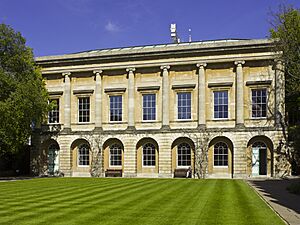
This area was originally a garden. In the early 1700s, more student housing was needed. So, two separate buildings were constructed. The first was the Robinson Building on the east side, built in 1720. Its twin, the Carter Building, was built on the west side in 1729. These two buildings stood alone in the garden for almost 100 years. Between 1817 and 1819, they were connected to the First Quad.
The north side of this quad holds the library and common rooms for senior members. It was designed in a classical style and built between 1788 and 1796. This was to hold the many books given by Edward, Baron Leigh. The building has two floors. The ground floor has the first common rooms built specifically for senior members in Oxford. The library is on the floor above.
On March 7, 1949, a fire started in the library roof. Over 300 books and many old papers were destroyed. More than 3,000 books needed fixing. Luckily, the main building structure was not badly damaged, and repairs took less than a year.
Third Quad (St Mary's Quad)
The south, east, and west sides of the Third Quad include parts of St Mary Hall. This hall became part of Oriel in 1902. Less than ten years later, the buildings on the north side of St Mary Hall were taken down to build the Rhodes Building.
On the south side, parts of the old medieval buildings still exist. The former Chapel, Hall, and shop (Buttery) of St Mary Hall, built in 1640, are now part of the Junior Library and Junior Common Room. From the Third Quad, you can see that the chapel was built directly on top of the hall. This is a unique design in Oxford.
On the east side of the quad is a simple wooden building called "the Dolls' House." It was built in 1743.
In 1826, a fancy building was put up by St Mary Hall on the west side of the quad. It was designed in a Gothic style and includes the old gate of St Mary Hall. It has two decorative oriel windows.
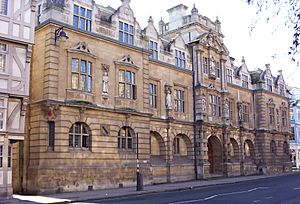
The Rhodes Building was built in 1911. It used £100,000 left to the college by a former student, Cecil Rhodes. It stands on the site of the old house of the St Mary Hall Principal, on the High Street. The building has decorations with the coats of arms of important people in the college's history. These include Sir Walter Raleigh, John Keble, Edward Hawkins, and Gilbert White.
Some people did not like the building when it was finished. The Mayor of Oxford said that Oriel had "destroyed a most picturesque group of old houses."
Statue of Cecil Rhodes
On the side of the Rhodes Building facing the High Street, there is a statue of Cecil Rhodes above the main entrance. Below him are statues of King Edward VII and King George V. These statues were made by the sculptor Henry Pegram. An inscription on the building acknowledges Rhodes's generosity.
The statue has been the subject of protests for several years. People have asked for it to be removed. In June 2020, many protestors again demanded its removal. However, on May 20, 2021, the college decided not to remove the statue. They said it would be too expensive and complicated. About 150 Oxford teachers stated they would not teach Oriel students more than they had to, to protest this decision.
Island Site (O'Brien Quad)
This area is a group of buildings bordered by the High Street and the meeting of Oriel Street and King Edward Street. It took 600 years for the college to acquire all this land. It has teaching rooms and a lecture theatre, but it is mostly used for student housing.
On the High Street, numbers 106 and 107 stand on the site of Tackley's Inn. This inn was built around 1295 and was the first property Adam de Brome bought for the college. It had a hall and rooms for scholars, with shops in the front. The south wall of the building still exists and has an old window from the 1300s. The cellar below is from the same time and is the best-preserved medieval cellar in Oxford.
Number 12 Oriel Street is the oldest building the college acquired. It was given to the college in 1392. In 1985, this building and others were renovated.

King Edward Street was created by the college between 1872 and 1873. Old shops were torn down and rebuilt. The road was named after the college's founder and opened in 1873. On the wall of number 6, there is a large metal plaque with a picture of Cecil Rhodes. It says that he lived in that house in 1881.
In the center of this quad is the Harris Building. This used to be a real tennis court. King Charles I played tennis here in 1642. King Edward VII had his first tennis lesson here in 1859. The building was used as a lecture hall by 1923. After being updated between 1991 and 1994, it now has student housing, a seminar room, and the college's main lecture theatre. The building was opened by John Major, who was the Prime Minister at the time, in 1993.
Rectory Road
This site is near the Cowley Road. It used to be Nazareth House, a care home that was also a convent. The Goldie Wing and Larmenier House are the remaining buildings from that time. Nazareth House itself was taken down to build two new student halls: James Mellon Hall and David Paterson House. These two new halls were opened by Queen Elizabeth II on November 8, 2000.
This site is about a ten-minute walk from the main college. It is quieter than the city center. It is a popular choice for Oriel's graduate students and final-year undergraduate students. The site has its own common rooms, a squash court, a gym, and staff to help students.
Bartlemas
Bartlemas is a special area that includes the remaining buildings of a hospital for people with leprosy. This hospital was founded by King Henry I. It also includes sports grounds for Oriel, Jesus, and Lincoln Colleges. There are also areas for wildlife and small buildings.
In 1326, Provost Adam de Brome was put in charge of St Bartholomew's. This hospital was later given to the college by King Edward III. It was also used as a place for sick college members to rest and get fresh air. In 1649, the college rebuilt the main hospital building as four almshouses (homes for poor people). The Bartlemas Chapel and two farm cottages are the other old buildings still standing.
Filming Location
The buildings of Oriel College have been used for filming movies and TV shows. These include Hugh Grant's first film, Privileged (1982), as well as Oxford Blues (1984), True Blue (1991), and The Dinosaur Hunter (2000). The TV crime series Inspector Morse used the college in several episodes. The follow-up series, Lewis, also used Oriel's common room and Oriel Square.
College Symbols
Coat of Arms
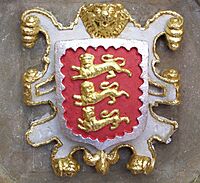
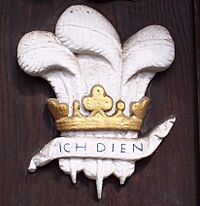
The college's coat of arms shows three golden lions walking on a red background, surrounded by a silver border. These arms are based on the royal arms of England because King Edward II founded Oriel. The border was added to show that it's a different version of the royal arms.
The Prince of Wales's feathers are often used as a symbol by members of the college. You can see them as decorations in the college buildings and on the official college tie. This symbol likely represents Edward, the Black Prince, who was the senior grandson of King Edward II. It might also represent King Charles I, who was Prince of Wales when the First Quad was built.
In 2009, the college was given permission to use a special heraldic badge. This badge is a blue tortoise with two silver rings. It is used by the boat club and a group of former rowing students.
Prayers and Graces
Oriel College has special prayers that are said during services. One of these prayers thanks God for the college's founder, Edward II, and other people who have helped the college. It asks that students use the opportunities given to them wisely.
A list of all the people who have given money or help to the college is read out on certain occasions.
Before formal dinners, a Latin prayer is said by a student. This prayer asks God to fill their hearts with joy and gladness so they can do good work.
After the meal, the provost or another leader might say a short Latin prayer. Or, a longer Latin prayer is said. This prayer thanks God for the founders and benefactors of the college. It asks that students use God's gifts well and reach eternal glory.
Student Life
All undergraduate students at Oriel are provided with a place to live. Some graduate students also have college accommodation. Students are usually expected to eat dinner in the main hall. There are two dinner times each evening, except on Saturdays.
Between 2001 and 2010, Oriel students chose not to be part of the Oxford University Student Union. In 2010, students voted to rejoin. However, in 2013, they voted again to leave the student union.
Arts at Oriel
Oriel has its own drama group called the Oriel Lions. This group helps fund college plays and shows at Oxford University.
The college also has a student-run publication called The Poor Print. It publishes news, poetry, photos, science articles, and more. Each issue has a theme. Students and staff contribute content. It started in 2013 as an online magazine and then began printing every two weeks in 2015.
Sports at Oriel
Croquet can be played in St Mary quad in the summer. Bowls can be played on the south lawn of First Quad. The sports ground at Bartlemas is used for many different sports.
Rowing
Rowing at Oriel College is managed by the Oriel College Boat Club. They row from the college's own boathouse near Christ Church Meadow. Oriel is well-known for its success in rowing, especially in the two intercollegiate races called Torpids and Eights Week.
As of 2018, Oriel has won the men's Torpids headship 33 times, which is more than any other college. They have also won the Summer Eights Headship 32 times, second only to Christ Church. From 1968 to 2018, Oriel won 25 headships. In 2006, Oriel was the first college to win both the men's and women's headships in Torpids. They did it again in 2018. Oriel is still the only college to have achieved this "double headship" in Torpids.
Besides the races in Oxford, Oriel crews also compete in other events. These include the Head of the River Race and the Henley Boat Races. In 2016, the men's first boat won a collegiate event at the Fairbairn Cup. They won again in 2017 and won the entire event in 2018.
In the book Tom Brown at Oxford, Oriel's win in the 1842 Head of the River Race was changed. The book's fictional college, "St Ambrose," took first place, with "Oriel" in second.
Famous People from Oriel
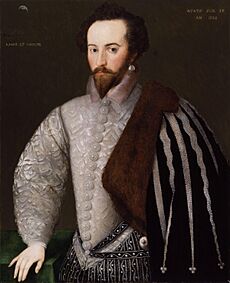
Oriel College has had many famous students and teachers. These include leaders, athletes, and business people. A well-known student in the 1500s was Sir Walter Raleigh, a famous explorer. The college also had teachers who started the Oxford Movement, like John Keble, Edward Bouverie Pusey, and John Henry Newman.
The college has also produced many church leaders, governors, and two Nobel Prize winners. These are Alexander R. Todd (for Chemistry in 1957) and James Meade (for Economic Sciences in 1977).
In the 1700s, Oriel welcomed its first students from America. These were sons of plantation owners from Virginia. One of these students, Thomas Fairfax, 6th Lord Fairfax of Cameron, later gave a job to a young surveyor named George Washington.
Special Items at Oriel
Oriel has three important pieces of old silverware. The first is a French cup with a lid, made of silver-gilt. It was bought in 1493. People mistakenly thought it belonged to King Edward II. It is called the Founder's Cup.
The second important item is a drinking bowl (mazer) made of maplewood with silver-gilt parts. It dates from 1470 to 1485. This type of bowl was common long ago. The only other similar bowls in Oxford belong to All Souls College. The third item is a coconut cup, which is one of only six in Oxford. Oriel's cup has silver-gilt parts and is from the early 1500s.
Other silver items include two large jugs, two small plates, and a chalice from 1640-1641. Larger pieces include special cups from the 1650s and 1660s, a bowl for rosewater from 1669, and a punchbowl from 1735-1736. The largest item is a big tankard from 1679, which holds a gallon. Many of the old tankards were given by students as part of their admission fee.
Oriel also has a copy of the Magna Carta, a very important historical document.
Images for kids
See also
 In Spanish: Oriel College para niños
In Spanish: Oriel College para niños


